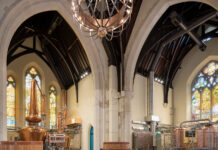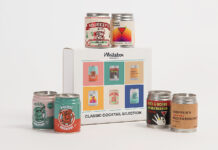Alexandre Gabriel of Maison Ferrand will be the Keynote Speaker of ADI’s 2022 Gin Summit.
Alexandre Gabriel is the owner and master blender of Maison Ferrand, a Cognac house with distilling roots stretching back more than four centuries. If that leads you to believe that Gabriel prizes tradition above all, well, you’d be mistaken.
After taking the helm at Maison Ferrand in the 1980s, Gabriel found himself with an opportunity. According to French law, Cognac can only be made during a portion of the year. The rest of the time, his stills sat empty. Could he make something in the off-season, he wondered–something like, say, gin?
In 1996, Maison Ferrand introduced Citadelle Gin, one of the very first artisanal gins on the market. Today, it’s widely recognized as an iconic product that virtually invented a new spirits category. As we gear up for the 2022 Gin Summit, where Gabriel will be the keynote speaker, ADI caught up with this giant of the gin world to hear more about how youthful exploits at French discos inspired his products, the formative role Ferran Adrià played in the revival of the gin & tonic, and why a little anger at bureaucracy can be a great motivator.
You mostly work with very traditional French spirits like Cognac, Armagnac, and Calvados. Gin stands out a bit! What drew you to it originally?
The madeleine de Proust for me was the memory of going to cheap French discos at 16 or 18 – the drinking age back then was 16 – and drinking bad gin and tonics. To me, we are all kind of stuck in those years that were so formative, for fashion, for music, for everything.
So I was attracted to gin emotionally, but it also made sense intellectually, because gin is the opposite of Cognac. Cognac is all about warmth and complexity. Gin is all about very defined freshness. Cognac is very, very regimented. Gin is basically a free for all. The only limit is your imagination. There is only really one rule, which is that it’s a spirit with a dominant flavor of juniper berries. It gave us the possibility to create with no limit. I am a creative guy, and creativity is fed by knowledge, but then you have to free your mind.
Citadelle Gin was introduced in 1996, well before the current “gin craze.” What was the response like at that time?
In retrospect, people tell me I really had vision. Then they ask, what’s the next trend? And I look at them with an empty stare and say “I have no clue what I was doing, I just did it.”
There’s a very typical French engineering culture: you make something, you do no marketing study, you launch, it’s a flop, and you think the world is unjust. I was that French guy, creating this gin, thinking that the world needs a great artisanal gin. And at first it didn’t.
What? It’s French! It’s gin! It’s artisanal! Nobody cared. Remember, in the 1990s, people said “I don’t need a great gin, I’m just mixing.” Now it sounds ridiculous to say that, but I’ve heard that a thousand times. And I almost went bust, because I believed in it, and when you believe in things, you over invest. I even have a patent for the distillation process because we invested so much.
My first break was when Ferran Adrià reinvented the gin and tonic on TV. My distributor called me and said, “You won’t believe it, he’s talking about the gin tonic as a gastronomic act.” At the time there was no artisanal tonic, so he made his own, and then he whips out a bottle of Citadelle Gin. My importer was ecstatic. Sure enough, we started shipping a pallet at a time.
The world caught fire about the gastronomic gin and tonic. I’ve read that Citadelle was originally conceived as a way to utilize distillation equipment outside of the distilling season in Cognac. Charentais stills are not traditional gin stills. How did you adapt that equipment to your purposes?
If you look at what the medieval guys were using, the alchemists, it’s basically the still we have in Cognac. The original genevers were made using a very similar still. It’s one of the most precise stills in the world. So to me, it was a natural choice, like using the original still to make gin. Of course, it’s slower and more expensive, but the equipment was already amortized.
It took us five years to convince French customs. I saw it as a frustrating thing. You’re young, you think the world is yours, and they say, “Wait a minute, young man, you can’t do this.” I said “Why”” They say, “There’s no rules that say you can.” And I was saying, “There’s no rules that say I can’t.”
One of the guys at customs was a historian who was a real history buff about spirits. He is unknown to the world because he was a customs officer. But he really liked it, and he really listened hard. It took a few years of convincing, and then we launched in ‘96.
How did you go about developing the recipe for Citadelle Gin?
I had five years on my hands, so I experimented with every technique I could think of. Cheap gins are just flavored vodka: low-level alcohol with the flavor of juniper You pay more the next morning than you did the day before. But with distilled gin, the flavors are attached by the act of distilling, so that’s of course what I was into.
Some people were just putting the botanicals in the still the day before, and then distilling the next day. I say why? They say, just because I do it that way. In the 1970s, people distilled the botanicals separately and blended them together. That’s called sequential distilling. I thought I would do this, but I realized that each botanical deserves a different treatment. Some elements are more soluble in alcohol so you need to infuse at a higher proof, some at a lower proof, some take a long time, some take a short time. So I thought, this is great, we can treat them separately and then blend them.
It didn’t work the way I wanted. It didn’t have fondu – that means integration of the
components into a new one. It was like a mosaic instead of a soft painting. I realized that
botanicals needed to be treated differently. So I invented a method that we call progressive infusion where we make a brew and integrate different botanicals progressively at a different proofs with mesh bags. That way you can have the perfect maceration when it goes into the still.
In retrospect I was frustrated with these years on my hands, but it was great because we could fine tune it. We were pissed off, so we had the energy to do it.
In addition to the classic Citadelle Gin, you’ve also introduced some line extensions. Can you tell us about those?
In 2008 we launched our first Reserve gin. I loved it because I could use wood types that are forbidden for Cognac, like chestnut, mulberry, and acacia. My grandfather was a vintner, and acacia for white wine is delicious. In his honor, the Reserve is dominant in acacia. Our Old Tom is also aged partly in acacia.
Jardin d’Éte was our Covid baby. We had this beautiful garden with cantaloupe and tomato, and the smells inspired me. Also, instead of distilling the skin of the lemon I started distilling the whole lemon in slices, so I really started thinking the quality of the lemon was really important.
There is something we call the fatal energy, or the energy that’s wasted. We recycle our water, so we need to cool it down. I thought, could we grow lemons and oranges in a greenhouse powered with energy by the lost heat from the distillery? So we put together a whole new system. We are building the orangerie out of local stone and glass. It will be finished in March of next year, and we’re going to grow our lemons and oranges from the energy of the distillery.
Want to learn more? Registration for ADI2022 and the ADI Gin Summit is open now. Go to distilling.com for more information








